PacketStorm
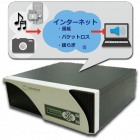
PacketStorm
PacketStorm Test & Emulation Test & Simulation » Network Emulator
PacketStorm series is an IP network emulator that can be applied to packets that pass through various emulated behavior such as delay, latency, packet drop, etc. that can happen on IP network.
PacketStorm also allows reproduce and verify the behavior when various network devices such as VoIP and video distribution actually encounter packets with various failures on the IP network.
- With intuitive and user-friendly GUI, users are able to operate the emulator's function quickly.
- Supports many possible failures on IP networks.
- Possible to easily emulate a network in which multiple network condition can be induced, in a complicated manner as well.
- The header of a passing packet can be modified (overwritten).
- The network status can be dynamically changed according to the passage of time, the number of passing packets, ToS, and used bandwidth.
- Filtering of various IP structures such as IP address, protocol, port number, packet length, etc. to identify the packets that causes a fault.
- It has useful functions for generating more realistic network emulation for development, experiment and verification assignment.
To operate PacketStorm, simply drag and drop icons that define filters and faults and connect them with lines.
This intuitive operation allows first-time users to quickly build emulations of faulty IP networks with little training required. In addition, you can easily set up a network in which multiple obstacle factors are involved, and you can grasp the status of the settings at a glance.
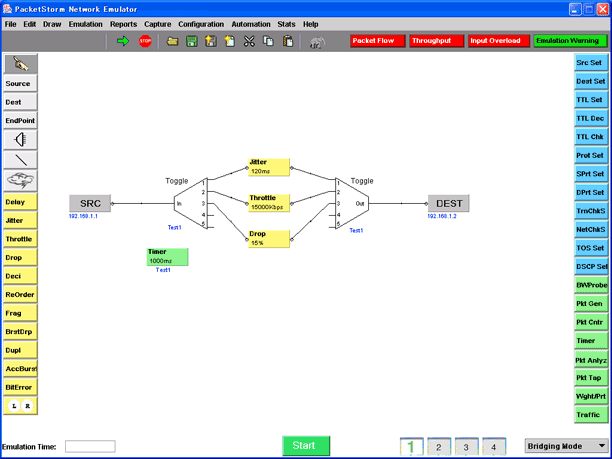
Simply place a fault icon between the source and destination icons on the screen, connect them with a line, and double-click each icon to set filters and fault parameters.
Up to 32 links can be created between the source and destination.
Various network variable blocks can be applied to PacketStorm via GUI. You can select a couple of them and group as a network under test.
(Click each item name to display the setting screen for that function.)
| Item | Description | Parameter |
|---|---|---|
| Delay | Induce delay to the packet | 0~10,000ms (*1) |
| Jitter | Generate fluctuation for the packet | 0~10,000ms (*2) |
| Throttle | Bandwidth limit | 0~1,000,000Kbps Queue:68~524,288Bytes |
| Drop | Drop packets at specific rate | 0~100% (*3) |
| Decimate | Drop one packet for every N packets | N=1~10,000 packet |
| ReOrder | Switch the order of packets | Number of packet hops:0~255 Occurrence frequency:0~50% |
| Fragment | Splits IP packets randomly | MTU:68~65,535 Occurrence frequency:0~100% |
| BurstDrop | Drop a large number of packets | Number of packets to drop: 0~65,535 Occurrence frequency:0~100% |
| Duplicate | Duplicate packets randomly | Occurrence frequency:0~100% |
| BitError | Causes a bit error | Range: 1e-18 to 0.5 Random/Periodic Payload Offset: 0 to 9,000 Bytes Burst: 2 to 65,535 bits |
| Sink | Discard all packets and emulate disconnection | – |
| MTU | Set the MTU value and fragment packets above this | MTU: 68-65,535 Send ICMP: Yes/No Ignore DF: Yes/No |
| MOS SET | Apply a fault that is equivalent to the set MOS value. | MOS:1.0~4.22 CODEC:Generic, G.711, G.711PLC, G.729, G.722, G.726 16K, G.726 24K, G.726 32K, G.726 40K, iLBC (20ms), iLBC (30ms), G.723 |
| AccumlateBurst (optional) |
Emulate network bursts | Burst size: 1 to 10,000 packets Queue: 1 to 20,000 Packets Time between bursts: 0 to 10,000 ms |
(*1)=Delay can select the following distributions:Fixed, Gaussian, Uniform, Exponential, BiModal
(*2)=itter can select the following distributions:Gaussian, Uniform, Exponential
(*3)=Drop You can also use the Gilbert Elliot Ross model.
PacketStorm can rewrite (alter) the information in the IP header of passing packets. Also, like the rewriting of IP address and TTL, multiple header information can be rewritten on one link, and it can be used together with the failure function such as delay and drop.
(Click each item name to display the setting screen for that function in a separate screen.)
| Item | Description |
|---|---|
| Set Source Address | Change the source IP address to any address |
| Set Destination Address | Change the destination IP address to any address |
| Set TTL | Change the TTL value to any value between 0 and 255 |
| TTL Check | Discard packets with a TTL value of 0. You can also send an ICMP message to the sender if you drop it |
| Set Link Protocol | Change the value of the protocol field from 0 to 255 |
| Set Source Port Number | Change the source port number to any value between 0 and 65,535 (TCP and UDP only) |
| Set Destination Port Number | Change the destination port number to any value between 0 and 65,535 (TCP and UDP only) |
| Set Transport Check Sum | Change TCP or UDP checksum to any value from 0 to 65,535 |
| Set Network Check Sum | Change the network checksum to any value between 0 and 65,535 |
| Set TOS | Change the value of the ToS field to any value in the range 1-5 |
| Set DSCP | Change the value of the DSCP field to any value between 0 and 63 |
| Calc ChkSm | Calculate the checksum of IP and/or TCP/UDP of the packet passing through this icon, and rewrite it with the calculated value |
| Frag Yes / Frag No | Change the value of Don't Fragment Flag |
| IPv6 Modifiers (optional) |
Change the header content of an IPv6 packet |
| MAC Modifier (optional) |
Change the source/destination MAC address or frame type/frame length to any value |
| MPLS Modifier (optional) |
Insert/delete MPLS Tag and change values such as Label, Experimental Bits, TTL |
| VLAN Modifier (optional) |
Insert/delete VLAN Tag and change values such as Priority, CFI, and VLAN ID |
| Universal Modifier (optional) |
4 bytes of data are arbitrarily changed from the specified offset position. It is also possible to recalculate the checksum after the change. |
| PWEth Mod (optional) |
Can rewrite L2TPv3 Tunnel ID, Tunnel Cookie and ECID/CES: ECID, L, R, M, FRG, Length, Sequence Number |
| RTP Mod (optional) |
You can rewrite Version, Padding, Extension, CSRC Count, Maker, Payload Type, Squence Number, Timestamp, SSRCid of RTP packet. |
PacketStorm is equipped with various packet filter functions so that it is possible to apply a fault to only a specific packet among the passing packets and rewrite the header.
PacketStorm can set up to 32 links. The following filters (single or combination) can be set for each of these links.
(Click each item name to display the setting screen for that function in a separate screen.)
| IP address(source) | IP address(destination) | Port number(source) |
| Port number(destination) | Protocol | Packet Length |
| Input physical port | Bit pattern (*1) | MPLS (*1) |
| MAC address (*1) | VLAN (*1) | IPv6 (*1) |
| Universal (*1) (*2) | MPEG2 (*1) | ATM PCV(*1) |
| PPPoE (*1) | ||
| (*1)=Option (*2)=Four bytes of data are collated and filtered from the offset specified by the user. |
||
PacketStorm is equipped with a number of unique functions to assist in device testing and verification while applying the above faults and rewriting headers. For details, click "Useful functions of PacketStorm" below, or click each item, and a new screen will guide you.
Useful features of PacketStorm
| Fork Icon | It is possible to dynamically change the fault to be applied and the rewriting of the header depending on the conditions such as the number of passing packets, time, ToS value, DiffServ value, and bandwidth used. |
|---|---|
| Sub model | Links that involve multiple obstacles in a complicated way can be collected, saved, and loaded in one cloud. |
| Bandwidth Probe | Shows the average throughput value and the amount of packets passed through at any point on the link. |
| Packet Tap | Show statistics at any position on the link. |
| CODEC | You can select 7 types of CODEC type to display MOS value and R value. |
| Link status display | Display packet drop, delay, R value, MOS value |
| Packet transit mode | For packets passing through PacketStorm, PacketStorm operates in one of the following modes. 1) Bridge mode 2) Port mirror mode 3) Static routing mode |
| Packet Tap | It displays the packet amount at any point, R value, MOS value during voice communication, DF and MLR during video communication. |
| Proxy Arp | The physical port set with Proxy Arp responds to all ARP requests. |
| Packet generator (optional) |
Generate TCP, UDP or ICMP packets |
| Packet analyzer (optional) |
Packet analysis can be performed anywhere on the link |
| Packet recorder (optional) |
Packets can be captured and stored at up to 16 locations |
| Traffic conditioning (optional) |
You can control the traffic flow on the link with 9 queue types |
| Capture and replay (optional) |
Measures the delay and packet loss between any node and PacketStorm in a realistic network and reflects them in emulation |
| TIA-921 and ITU G.1050 (optional) |
Performance verification of multimedia applications can be performed with the network model (1064 test scenario) specified by TIA-921 and ITU G.1050. |
| Data replay (optional) |
Generate packets from data obtained with a packet analyzer or other compatible capture file. |
| Insert data (optional) |
Insert 1 to 4 bytes of data at the offset position after the IP header |
| Delete data (optional) |
Delete 1 to 4 bytes of data from the offset position after the IP header |
| Ethernet jumbo packet (optional) |
Can handle jumbo packets |
PacketStorm has a lineup of three types. You can select the most suitable model according to your application.
| Model | Maximum throughput | Number of slots available | Compatible interface |
|---|---|---|---|
| 200E | 400k pps | Fixed | 10/100/1000 BASE-T RJ45 I/F |
| 400E | 900k pps | 1 | 10/100/1000 BASE-T RJ45 I/F
or Gigabit Ethernet SFP I/F |
| HurricaneⅢ | 1,200k pps | 5 | Gigabit Ethernet Fiber I/F – Multi Mode SFP supplied
or 10/100/1000 Ethernet copper I/F or 1G/10G Fiber I/F – Multi Mode SFP supplied |
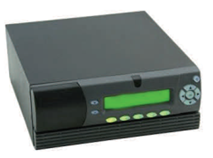 |
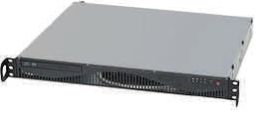 |
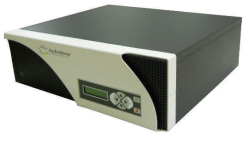 |
| PacketStorm 200E | PacketStorm 400E | PacketStorm HurricaneⅢ |
